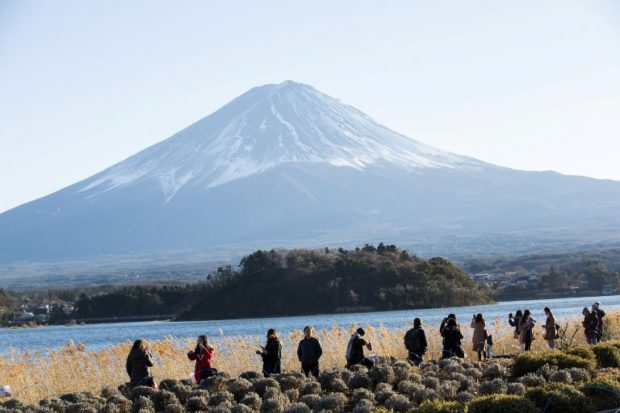
In this picture taken on January 2, 2018, tourists stroll by Lake Kawaguchi overlooking Mount Fuji in the town of Fujikawaguchiko, Yamanashi prefecture. / AFP PHOTO
Japan’s iconic Mount Fuji could paralyze Tokyo with ash if it erupted, choking roads and halting water supplies, according to a government disaster planning study, a news report said Tuesday.
The snow-capped peak of the country’s highest mountain 100 kilometers (62 miles) west of Tokyo is a symbol of Japan — and is also an active volcano.
It last erupted in 1707, but while it has not shown any signs of life in recent decades a potential eruption now could shower more than 10 centimeters (4 inches) of ash on central Tokyo, according to a government study seen by the Kyodo news agency.
The ash would paralyze the capital, rendering roads impassable and stopping the flow of goods and people.
The study found just 0.5 centimeters of ash could cause mechanical problems for cars and more than one centimeter could cause mass power outages and the failure of water filtration systems, Kyodo reported.
Noriko Urata, an official in charge of disaster research, confirmed the government is assessing the possible impact of an eruption and preparing measures to deal with the scenario.
“But we are not in a position to unveil details,” he told AFP.
In the past, the government has estimated that an eruption could result in damage and losses worth over 2.5 trillion yen ($23 billion).
“But if we include the impact on aviation and other transportation as well as secondary infrastructure, the cost could be far more than two trillion yen,” said Toshiyasu Nagao, head of Tokai University’s Earthquake Prediction Research Centre.
“Mount Fuji is categorized a young volcano,” Nagao told AFP. “It would be no surprise if Mount Fuji erupts any time in the near future.”
Japan, with more than 110 active volcanoes, sits on the so-called Pacific “Ring of Fire” where a large proportion of the world’s earthquakes and volcanic eruptions are recorded.
In January, a Japanese soldier was killed and several other people injured after an eruption near a popular ski resort in northwest of Tokyo.
On September 27, 2014, Japan suffered its deadliest eruption in almost 90 years when Mount Ontake, in central Nagano prefecture, burst unexpectedly to life.
An estimated 63 people were killed in the shock eruption which occurred as the peak was packed with hikers out to see the region’s spectacular autumn colors.